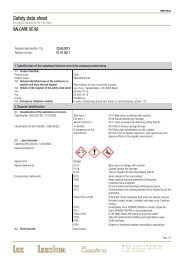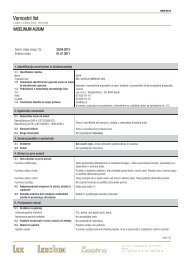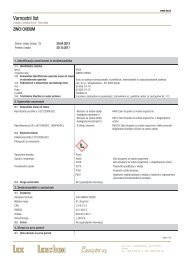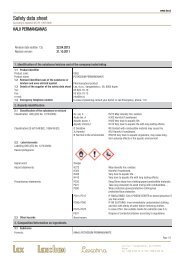Safety data sheet - Lex doo
Safety data sheet - Lex doo
Safety data sheet - Lex doo
Create successful ePaper yourself
Turn your PDF publications into a flip-book with our unique Google optimized e-Paper software.
www.lex.si<br />
<strong>Safety</strong> <strong>data</strong> <strong>sheet</strong><br />
According to regulation (EC) N o . 1907/2006<br />
ALCOHOL BENZYLICUS<br />
Revision date (edition 13): 06.05.2013<br />
Replace version: 16.11.2012<br />
1. Identification of the substance/mixture and of the company/undertaking<br />
1.1 Product identifier<br />
Product code:<br />
Product name:<br />
1.2 Relevant identified uses of the substance or<br />
mixture and uses advised against<br />
1.3 Details of the supplier of the safety <strong>data</strong> <strong>sheet</strong><br />
Tel.:<br />
Fax:<br />
e-mail:<br />
1.4 Emergency telephone number<br />
0966<br />
BENZYL ALCOHOL<br />
No information available.<br />
<strong>Lex</strong>, d.o.o., Vanganelska c. 26, 6000 Koper<br />
05 625-18-10<br />
05 625-18-12<br />
info@lex.si<br />
In case of poisoning consult your doctor or call Emergency, phone: 112.<br />
2. Hazards identification<br />
2.1 Classification of the substance or mixture<br />
Classification GHS ((EC) No. 1272/2008): Acute Tox. 4<br />
Acute Tox. 4<br />
H302 Harmful if swallowed.<br />
H332 Harmful if inhaled.<br />
Classification ES (67/548/EEC, 1999/45/EC): Xn Harmful R20/22 Harmful by inhalation and if swallowed.<br />
2.2 Label elements<br />
Labelling GHS ((EC) No. 1272/2008):<br />
Hazard pictograms:<br />
Signal word:<br />
Hazard statements:<br />
Precautionary statements:<br />
Warning<br />
H302<br />
H332<br />
P280<br />
P301+P313<br />
2.3 Other hazards None known.<br />
Harmful if swallowed.<br />
Harmful if inhaled.<br />
Wear protective gloves/protective clothing/eye protection/<br />
face protection.<br />
IF SWALLOWED:Get medical advice/attention.<br />
3. Composition/Information on ingredients<br />
3.1 Substance<br />
Chemical formula:<br />
C7H8O BENZYL ALCOHOL<br />
Molar mass:<br />
108,1 g/mol<br />
CAS: 100-51-6<br />
EINECS: 202-859-9<br />
Index: 603-057-00-5<br />
3.2 Mixtures No information available.<br />
4. First aid measures<br />
4.1 Description of first aid measures<br />
Inhalation:<br />
Skin contact:<br />
Eye contact:<br />
Bring the person out of the contaminated area to fresh air, assure medical help immediately.<br />
Show product label or this MSDS.<br />
Take off contaminated clothes and shoes, wash immediately with plenty of water and soap.<br />
Rinse out with plenty of water with the eyelid wide open. Call in ophthalmologist.<br />
Page 1/4<br />
<strong>Lex</strong> d.o.o. • Vanganelska c. 26 • SI-6000<br />
Koper<br />
tel.: +386 5 625 18 10 • fax: +386 5 625 18<br />
12<br />
www.lex.si • www.lexarna.si
<strong>Safety</strong> <strong>data</strong> Sheet (according to Regulation (EC) no. 1907/2006)<br />
ALCOHOL BENZYLICUS<br />
product code: 0966<br />
Ingestion:<br />
4.2 Most important symptoms and effects, both<br />
acute and delayed<br />
4.3 Indication of immediate medical attention and<br />
special treatment needed<br />
Drink plenty of water. Avoid vomiting. Danger of aspiration! Get medical advice.<br />
No information available. See also chapter 11.<br />
Medical advice: gastrolavage.<br />
5. Fire-fighting measures<br />
5.1 Extinguishing media All regular extinguishing media can be used. Select fire fighting measures suitable to<br />
surrounding environment.<br />
5.2 Special hazards arising from the substance or<br />
mixture<br />
5.3 Advice for fire-fighters<br />
Special protective equipment for fire-fighters:<br />
Additional information:<br />
6. Accidental release measures<br />
Combustible. Vapours heavier/denser than air. With air explosive mixtures can be formed.<br />
Suitable protective clothes and respiratory protection<br />
Prevent fire-extinguishing water from contaminating surface water, the ground water system or<br />
soil. Residues must be deposited according to local regulations.<br />
6.1 Personal precautions: Avoid contact with substance. Do not inhale vapours. Good ventilation of working place.<br />
6.2 Environmental precautions Prevent from entering into surface water, the ground water system or soil.<br />
6.3 Methods and materials for containment and<br />
cleaning up<br />
Absorb with liquid-binding material: sand, silica gel, acid binder, universal binder, saw dust.<br />
Disposal according to section 13 of this MSDS.<br />
6.4 Reference to other sections Any information regarding personal protection and disposal can be found in sections 8 and 13.<br />
7. Handling and storage<br />
7.1 Precautions for safe handling Ensure good ventilation/exhaustion at the workplace. Handling corresponding to laboratory<br />
safety guidelines. Keep away from ignition sources. Do not smoke.<br />
7.2 Conditions for safe storage, including any<br />
incompatibilities<br />
Requirements for storage areas and containers:<br />
Advices on common storage:<br />
VCI storage class:<br />
Keep container tightly closed. Store at a good ventilated place. Keep away from heat and<br />
ignition sources. Store at a cool place (+2 to +8 °C).<br />
Not required.<br />
7.3 Specific end uses No information available.<br />
8. Exposure controls/personal protection<br />
8.1 Control parameters No information available.<br />
8.2 Exposure controls<br />
General protective and hygiene measures:<br />
Respiratory protection:<br />
Hand protection:<br />
Eye protection:<br />
9. Physical and chemical properties<br />
3 B<br />
9.1 Information on basic physical and chemical properties<br />
Form:<br />
Colour:<br />
Odour:<br />
The usual precaution measures during handling of chemicals are to observe.<br />
Only required if aerosols or vapours are generated.<br />
Protection gloves of rubber or latex or PVC, for full contact 15 minutes maximum: neopren.<br />
Suitable gloves for enduring contact, material: nitrile rubber/nitrile latex, penetration time ><br />
480 min., thickness: 0,35 mm.<br />
<strong>Safety</strong> glasses<br />
liquid<br />
colourless<br />
characteristic<br />
Melting point: -15,3 °C<br />
Boiling point: 205,4 °C<br />
Flash point:<br />
Explosion hazard:<br />
101 ˚C<br />
Explosion limits: lower: 1,3 vol. %<br />
upper: 13 vol. %<br />
Vapour pressure: (20 ˚C) 0,13 hPa<br />
The product is not explosive, but explosive mixtures of vapour with air can be formed.<br />
Page 2/4<br />
<strong>Lex</strong> d.o.o. • Vanganelska c. 26 • SI-6000<br />
Koper<br />
tel.: +386 5 625 18 10 • fax: +386 5 625 18<br />
12<br />
www.lex.si • www.lexarna.si
<strong>Safety</strong> <strong>data</strong> Sheet (according to Regulation (EC) no. 1907/2006)<br />
ALCOHOL BENZYLICUS<br />
product code: 0966<br />
Density: (20 ˚C) 1,04 g/cm 3<br />
Solubility in water: (20 ˚C) 39 g/l<br />
9.2 Other <strong>data</strong> No information available.<br />
10. Stability and reactivity<br />
10.1 Reactivity No information available.<br />
10.2 Chemical stability No information available.<br />
10.3 Possibility of hazardous reactions No information available.<br />
10.4 Conditions to avoid No information available.<br />
10.5 Incompatible materials Oxidizing agents, non-metal halogenides, concentrated sulphuric acid, polymerisation initiators.<br />
Unsuitable materials: some plastics.<br />
10.6 Hazardous decomposition products No information available.<br />
11. Toxicological information<br />
11.1 Information on toxicological effects<br />
Acute toxicity:<br />
Carcinogenicity:<br />
Other information:<br />
12. Ecological information<br />
12.1 Toxicity<br />
Aquatic toxicity:<br />
Draize test, rabbit, skin: 100 mg/24 h moderate<br />
LC50 (inhalation, mouse): > 500 mg/m 3<br />
LC50 (inhalation, rat): > 500 mg/m 3<br />
LD50 (oral, mouse): 1360 mg/kg<br />
LD50 (oral, rabbit): 1040 mg/kg<br />
LD50 (skin, rabbit): 2000 mg/kg<br />
LD50 (skin, rat): 100 pph/90M<br />
According to ACGIH, IARC, NTP, or CA Prop 65 not classified as carcinogene.<br />
See actual entry in RTECS for complete information.<br />
Fish toxicity (LC50): Leuciscus idus 646 mg/l/48h<br />
Daphnia toxicity (EC50): Daphnia magna 400 mg/l<br />
Bacteria toxicity (EC50): Pseudomonas putida > 658 mg/l<br />
Algea l toxicity (EC50): Scenedesmus quadrica 640 mg/l/96h<br />
Behaviour in sewage plants: Activated sludge bacteria in a model sewage plant are not harmed by concentrations of 100<br />
mg/l.<br />
General advices:<br />
12.2 Persistence and degradability Elimination: > 90 %<br />
12.3 Bioaccumulative potential No information available.<br />
12.4 Mobility in soil No information available.<br />
12.5 Results of PBT and vPvB assessment No information available.<br />
12.6 Other adverse effects No information available.<br />
13. Disposal considerations<br />
13.1 Waste treatment methods<br />
Product:<br />
Packaging:<br />
14. Transport information<br />
Not classified as dangerous in the meaning of transport regulations.<br />
15. Regulatory information<br />
Water hazard class (German regulation) 1 (VwVwS): slightly hazardous for water. Prevent from<br />
leaking into ground water, environment waters or drainage.<br />
Reuse, if possible. The residues of the product are to be considered special hazardous waste.<br />
<strong>Lex</strong> product packaging must be disposed of in compliance with the country specific regulations<br />
or must be passed to a packaging return system. Under www.slopak.si you will find special<br />
information on the respective national conditions.<br />
Chemicals must be disposed of in compliance with the respective national regulations. Under<br />
www.slopak.si you will find country and substance specific information for disposal.<br />
15.1 <strong>Safety</strong>, health and environmental regulations/legislation specific for the substance or mixture<br />
Classification GHS ((EC) No. 1272/2008)<br />
NIOSH -Registry of toxic effects of chemicals substances (1983)<br />
Page 3/4<br />
<strong>Lex</strong> d.o.o. • Vanganelska c. 26 • SI-6000<br />
Koper<br />
tel.: +386 5 625 18 10 • fax: +386 5 625 18<br />
12<br />
www.lex.si • www.lexarna.si
<strong>Safety</strong> <strong>data</strong> Sheet (according to Regulation (EC) no. 1907/2006)<br />
ALCOHOL BENZYLICUS<br />
product code: 0966<br />
I.N.R.S. -Fiche toxicologique<br />
15.2 Chemical <strong>Safety</strong> Assessment No chemical safety assessment has been processed for the mixture and the substances it<br />
contains.<br />
16. Other information<br />
Full text of H-Statements referred to under section 2.<br />
H302 Harmful if swallowed.<br />
H332 Harmful if inhaled.<br />
Full text of R-phrases referred to under section 2.<br />
R20/22 Harmful by inhalation and if swallowed.<br />
Further information<br />
Other information: This version replaces all previous versions.<br />
Page 4/4<br />
<strong>Lex</strong> d.o.o. • Vanganelska c. 26 • SI-6000<br />
Koper<br />
tel.: +386 5 625 18 10 • fax: +386 5 625 18<br />
12<br />
www.lex.si • www.lexarna.si

















